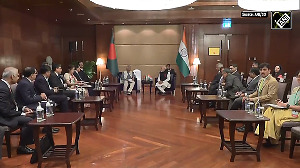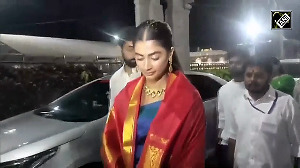While the craft of Kutch can be found in many cities, there is nothing quite like wandering into the very homes where it originates and watch it all being created in real time, discovers Supriya Newar.

The villages of Kutch, or Kachch as it is also written, may be tucked away in a corner of the country, but its craft and artistry are recognised and applauded by a much wider audience.
Having explored the (Beauty And Sadness At The Ruins Of Dholavira), a UNESCO World Heritage site, we now set our eyes at the other marvel of the region -- its traditional craft.
While the craft of Kutch can be found at leading showrooms at so many cities and for famous labels, there is nothing quite like wandering into the very homes and studios where it originates and watch it all being fashioned and created in real time.

From printing to pottery, from weaving to wood carving, from knife work to leather art and painting, the diversity of crafts found in this relatively small region of the world is perhaps quite unmatched.
Despite the aridity and heat, we comb its dusty lanes for two days and meet its many award-winning vankarss (weavers), karigars (craftsmen) and luhars (blacksmiths and ironsmiths).
Strand by strand
Abdulgafur Khatri, more popularly known as Gafur Bhai, has every reason to sit tall and proud as the patriarch of not just his family, but the entire village of Nirona, which has found a place on the crafts map, thanks to the art of Rogan he has kept alive and thriving.
From being awarded the Padma Shri, to being mentioned by Prime Minister Narendra Modi in one of his speeches, to being featured by countless media including the Discovery Channel, Gafur Bhai has almost single-handedly driven the resurgence of Rogan art and ensured its succession and continuity by imparting training and skills to both the boys and girls of the village.
Originating in Persia, Rogan is an art form where castor oil is mixed with coloured pigments and boiled to form a thick, stretchy paste.
The artist then takes a blob of that paste, after it has cooled down, on the mound of his hand, usually the left one, and using a stylus-like stick, takes strands of that paste and forms elaborate motifs and designs directly on the textiles, usually of a darker hue.
Every string of paste that goes into forming the various motifs and designs, goes straight onto the cloth, without any prior drawing or sketching or reference.
What is required thus, is not just conceptualising these intricate designs in the mind, before it lands on the fabric, but also absolute control of the hand that strings elaborate designs together, strand by strand.
Such is the finesse of every completed work, that from a distance, the art looks more like embroidery, dues to the thickness of the castor oil and the use of a stylus instead of a fine-tipped brush.
One of the most popular themes of this art form is the Tree of Life, which is made in different colours and sizes and was also gifted by Modi to then US president Barack Obama. One such Tree of Life that I saw coming to life now adorns my wall too!

For whom the bells may toll
For anybody with a flair for sound, a stop at the Copper Bell Art Studio, run by Faruk Hussain, a luhar, is a must visit.
The Hussain family have a god-gifted sense of sound and music, besides having a magical hand with scrap metal, that they have been beating and hammering into shape for umpteen years, to produce all kinds of bells and chimes and even small musical instruments, particularly those popular with folk artists, like those who play the morchhang (used in both Carnatic and Rajasthan folk music).

As we take off our shoes and enter a small room, we find the magician septuagenarian Hussain seated on the ground with a few pieces of unremarkable scrap metal lying around. Every inch of the wall behind him is adorned with bells and chimes and other metallic artefacts, both for display and sale.
Whilst the senior artist greets us with a twinkling eye and gets down to an immediate live demonstration with a hammer in his left hand, his son Faruk carries out the explanation.
He shares that his family has been making copper bells for over seven generations and have thus earned the title of being luhars. Faruk explains how the bells are made entirely by hammering a piece of metal and it is by hammering it in different ways, that the bells sound different in pitch and resonance.
The most fascinating bit of the bell making is that an entire bell, including even the very complicated designs that entail several bells stitched together, are entirely jointless and sans any welding.
The key lies in hammering the metals correctly and then interlocking them. Faruk goes on to explain how every bell, once beaten into shape, is put in a brick kiln with a coat of paste and finally gets a wooden clapper attached to it.
Done with his live demonstration, the senior artist looks up at us and gives us a beaming smile. He can infuse all kinds of sounds in his bells -- from the chirping of birds to the sound of rain or the jingling of ghungroos!
And where and how did he learn all of it? Just by watching, just organically and just by playing with metals from his childhood days, he chimes simply.
Making it look quite like child's play, the luhars have a steady stream of tourists and bloggers who seek their mastery out.And each time, someone from the family, obliges with a smile and a live demonstration, as they beat bits of waste into a chime.

Warp and weft
An off white and blue Kala Cotton saree, purchased from Kutch, hangs in my closet amongst some of my other prized looms. A rather coarse fabric, it has neither the sheen of silk nor the sophistication of linen. And yet, it has never failed to fetch me a compliment or two, each time I have draped it.
For those who know and recognise it, Kala Cotton is a precious and signature weave of Kutch.
A young, gifted weaver, Haresh explains that the Kala cotton crop is indigenous to the region and is free of any chemicals or pesticides, thus making it absolutely organic. As he sits on his loom, he goes on enlightening us about how Kala has a short staple length compared to other textiles and is therefore more difficult to spin and weave.
But Haresh, just like hundreds of others from his community, has been weaving Rabari blankets since he was a teenager and is now as an expert at the loom, bringing to life the traditional Kutchi motifs on shawls, dupattas and sarees with his rhythmic warp and weft of the loom.
Kala Cotton as a fabric is now being looked at quite seriously by leading designers who are styling it for furnishings and denims.
There is an inspiring sense of contentment palpable in each of these craftsmen and their homes. Whilst they take tremendous pride in their legacy and craft and excel at what they do, they have remained rooted in their ecology and land, learnt their art through a process of osmosis and passed it on as organically as the way they once picked it up, ensuring that each of these art forms is carried forward.
It is perhaps regions and art forms such as these that justify the tag of India being truly incredible.
Best time to visit
Between October to February. Summers are scorching.
Getting there
Reach Ahmedabad. Then an overnight bus or train will get you to Kutch. And then a drive.
Must buys
Copper bells, Ajrakh fabrics, Kala Cotton shawls, dupattas, sarees, leather crafted items and Rogan art and more. UPI is easily accepted. They can also gift wrap items or courier them across to an address within the country.
Most artists have Instagram pages where they post regularly.
Supriya Newar is a writer and poet from Kolkata. Besides being a music aficionado, she is also an avid traveller, particularly drawn to places that have a je ne sais quoi about them. She may be reached on connect@supriyanewar.com. Her website is www.supriyanewar.com
Feature Presentation: Ashish Narsale/Rediff.com











 © 2025
© 2025